Mining Companies: How to Transform your Culture
Mining companies are at a point of reckoning; in short, cultural issues are endemic to the industry. They must transform. And whilst each organisation will have its own unique culture, we argue that all cultures should feature psychological safety as a foundational element. Access our insight on how to change your company’s culture, sustainably.
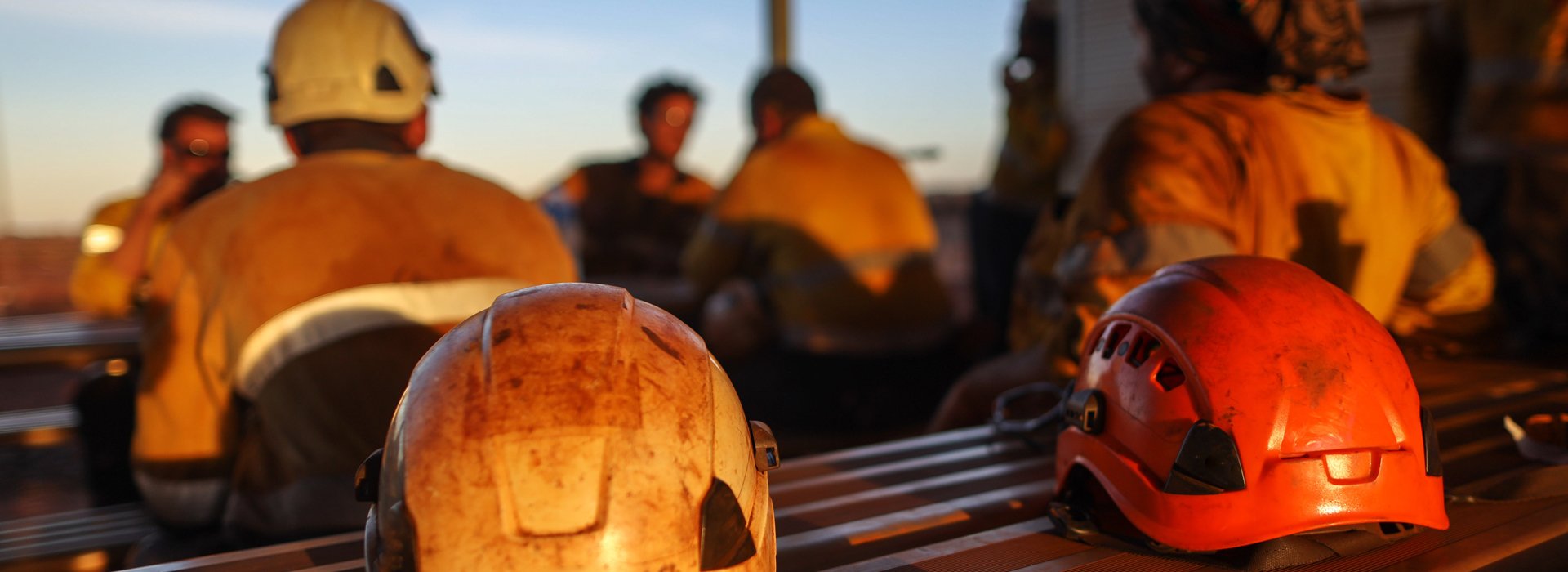
“Culture in Mining – Part 1” introduced our recommendations on how to instigate a step change towards cultural transformation. This second part addresses the next steps. Once you’ve settled on the culture you want to achieve: How do you implement it? What steps can you take to bring your teams on board? How do you know you’re being successful?
Mining companies are at a point of reckoning. In short, cultural issues are endemic to the industry. They can no longer claim a lack of awareness or discount the matter as merely isolated incidents. They must act to tackle and transform.
Changing culture is not a linear process
Transforming a culture is not easy, for many reasons. The most confronting for mining professionals is that it falls under the category of adaptive challenges. What does that mean and why does it matter?
Adaptive challenges are complex and ambiguous in nature, and their solution does not follow a “correct” or “incorrect” pattern. Rather, this type of problem usually requires people to learn new ways of operating, to change their attitudes, values and norms. In other words, they must adopt an experimental mindset, also called a growth mindset. Addressing adaptive challenges will usually involve the following pattern – try, fail, learn, try again, repeat – until a satisfactory outcome is reached.
In a mining environment, technical challenges – those with known solutions – are far more prevalent than adaptive challenges. As a result, the mining workforce is comprised of professionals whose background and expertise has mostly been geared towards solving these technical problems.
Faced with an adaptive challenge, it is understandable many mining industry leaders adopt remedial mechanisms that have worked for them in the past – those geared towards technical problems. However, these will not work when tackling culture transformation.
Prioritising the development of a growth mindset within your teams will ultimately bear fruit, but it is worth acknowledging this is a time and resource intensive process.
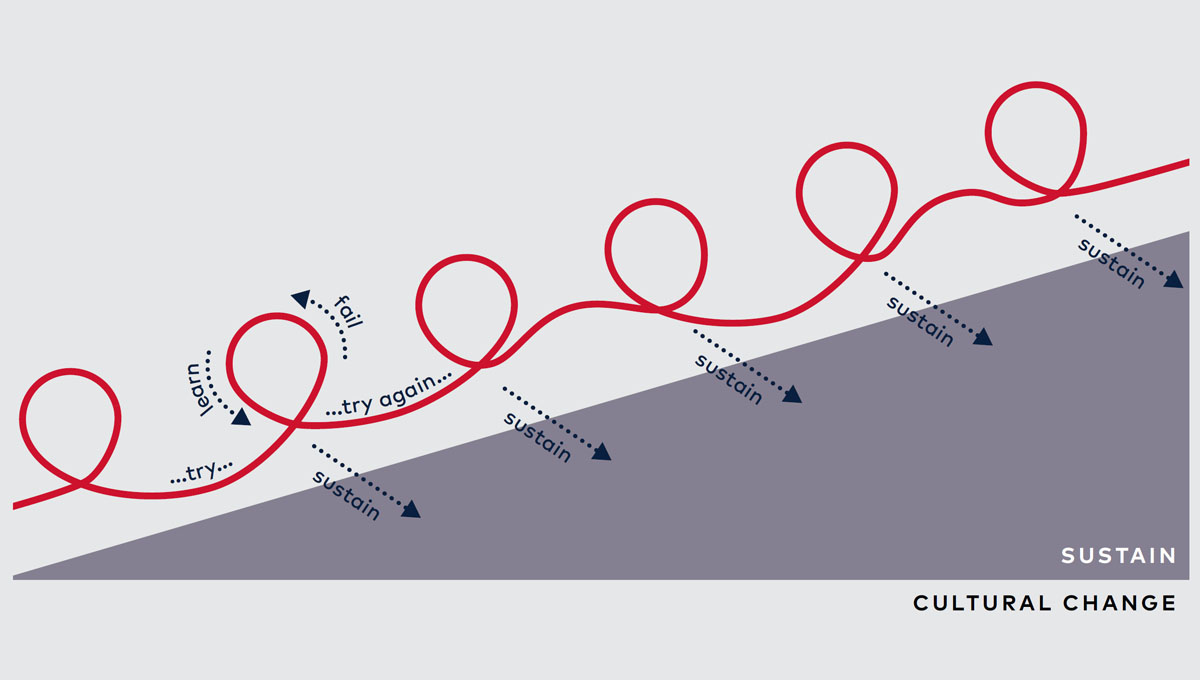
Which steps to take to create a psychologically safe culture in mining
As discussed in our first paper, each organisation should start by defining its own desired culture, based on its mission, vision, and operating environment. Critically, one foundational element common to all cultures should be the organisation’s commitment to a psychologically-safe workplace – see side bar. Then communicate “What Good Looks Like,” and put in place an environment where it is acceptable to fail, as long as you learn from it. Get ready to tackle the adaptive challenge that culture transformation is.
The next phase is the hardest one. How do you actually transform your organisation’s culture, to a state where each individual feels psychologically safe and contributes productively to your company’s overall wellbeing – from a human, operational and financial standpoint?
The model below describes the four factors that influence the personal values an individual holds. These are largely within their control.
Individuals, with their inherent personal values, operate within a workplace. That workplace’s physical environment, social context and especially the commitment of leadership also influences the personal values of each individual.
The constant interactions of individuals with the broader context creates ongoing fluctuations on how each individual impacts the company’s culture – and vice versa. This must be managed on an ongoing basis, to ensure the organisation’s culture remains aligned with its intent.
| Psychologically Safe A psychologically safe culture refers to a workplace where everyone feels they are able to have a voice, and that their voice is valued and respected. In this type of culture, everyone flourishes and contributes their optimum to the company’s mission. |
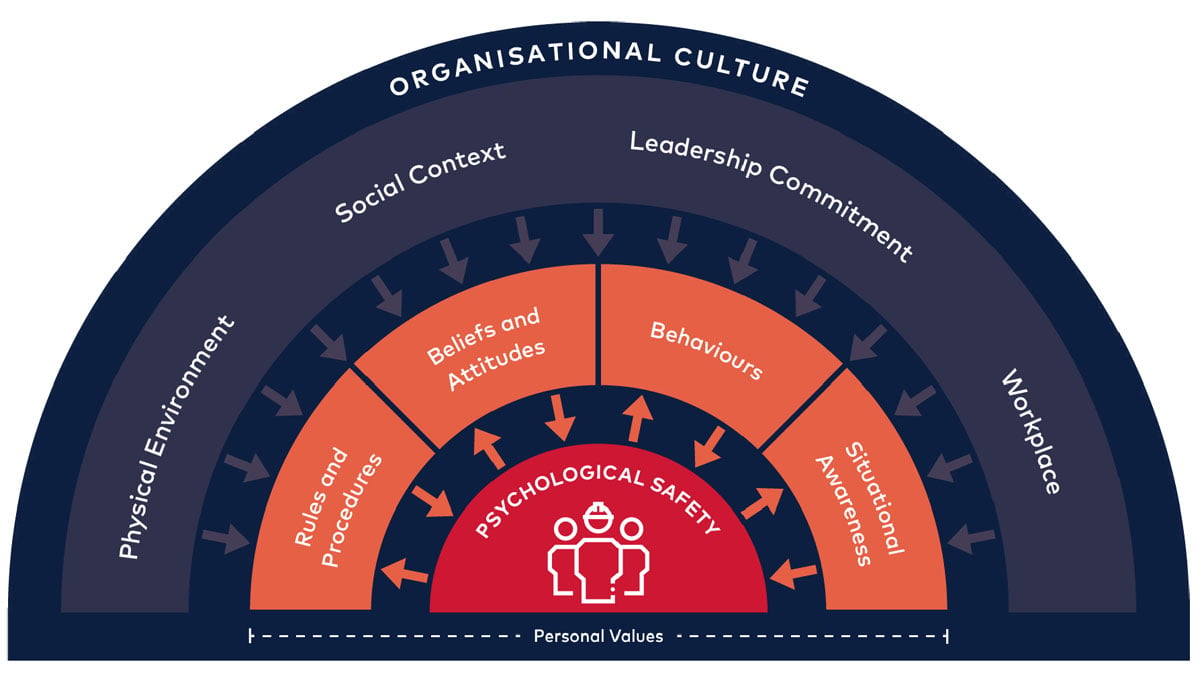
Practically, you will want to influence change through the following broad categories. Here are a few pointers to help you initiate the planning process.
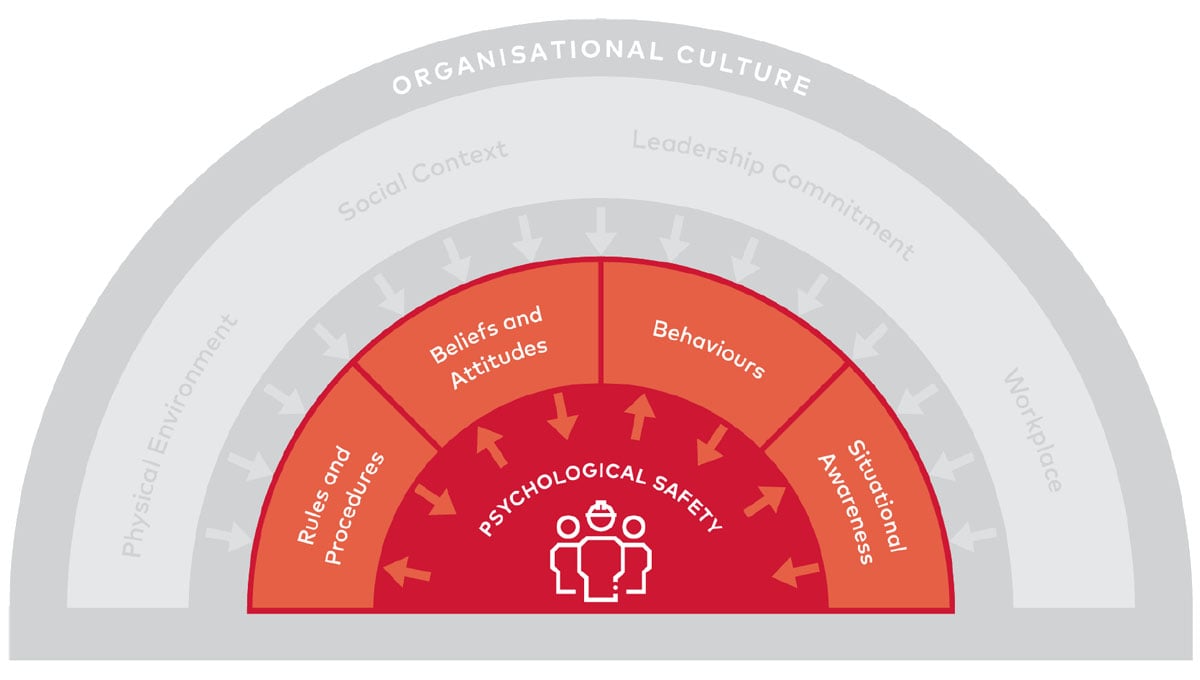
Rules and procedures
Your rules and procedures clarify the behaviours you want.
Are these explicit enough? Are they aligned with your statement of “What Good Looks Like?” Are they integrated into the life cycle of an employee (recruitment, induction, training, KPIs, performance reviews, promotions, exit interviews)? When an incident occurs, can your employees have confidence in the reporting system? Does that system place undue burden on the person reporting the incident?
Beliefs and attitudes
Beliefs drive behaviours. What we really think has a direct correlation to our actions – especially when no one is watching.
Our beliefs and attitudes have been influenced by our life experiences. However, every single individual can be challenged to think differently when introduced to new information or seeing others, especially those they respect, behaving differently. We will easily adapt our thinking and behaviours if it makes sense to do so. The organisation must drive that change, and promote a growth mindset approach for its workforce.
Behaviours
Endorse behaviours that align with your desired culture.
What actions are rewarded and what actions are corrected? How are you verifying that rules and procedures designed to create a psychologically safe culture are being followed? How do you actively and explicitly promote the behaviours you want and those you will not tolerate? How will you encourage the “okay to try and fail” growth mindset necessary to culture change?
Situational awareness
Seeing when a situation or behaviour is creating a risk to psychological safety is critical.
The dominant culture naturally feels psychologically safe and may have unconscious bias or blind spots. Encouraging diversity and being genuinely inclusive increases situational awareness and ultimately creates culture change.
Turning theory into reality
There are a multitude of concrete actions organisations can take to move ahead and set up an environment which will enable a psychologically safe culture to flourish.
To increase take-up, culture must be positioned as a safety issue. Until now, mining professionals have mostly focused on physical safety. This is but an evolution. Our experience has shown that driving culture change through the safety lens helps accelerate the change due to the common belief that a workplace should be safe. As everyone in mining knows: Safety is Everyone’s Responsibility.
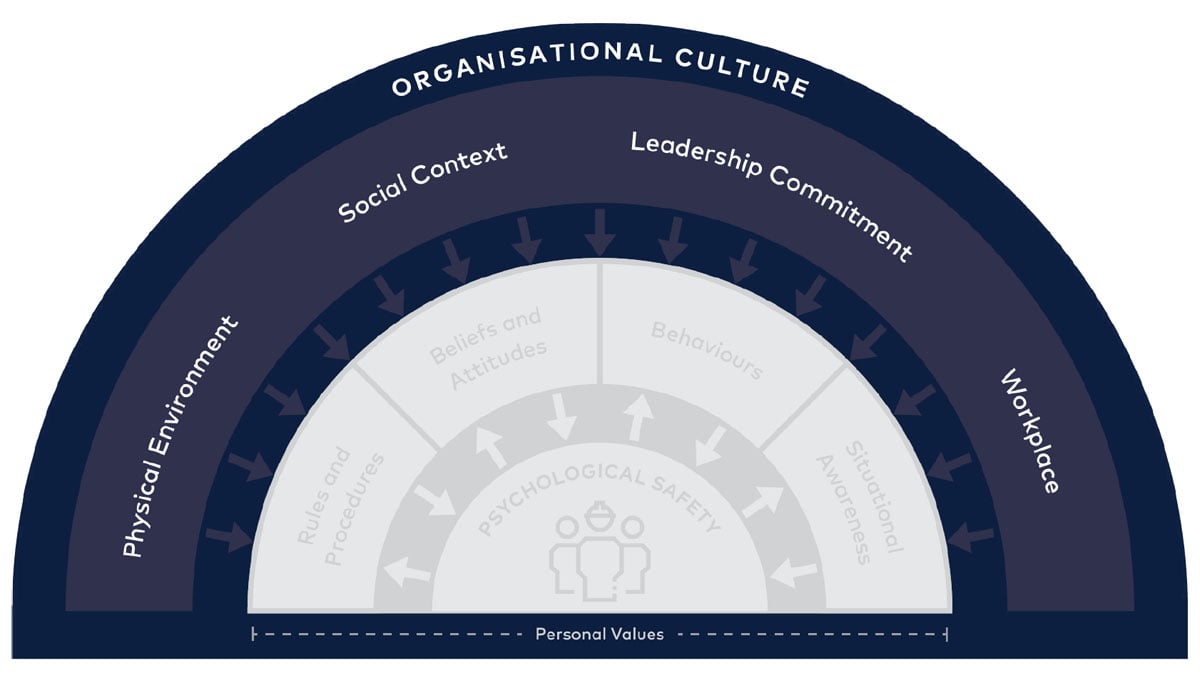
Physical environment
Your surroundings send a message about your company’s degree of inclusion and commitment to a diverse culture.
The physical environment includes equipment, roads, camp, facilities, and even your uniforms. It also includes what is posted on the walls, desks, and in the cabs. Does your current environment reflect your aspirations for culture transformation, or does it reflect your old culture? Ask those more diverse how the physical environment can be more inclusive.
Leadership commitment
Leaders can powerfully influence an individual by how they role-model what they talk about.
“What interests my leader fascinates me”. Leaders can and should manage compliance to rules and procedures. They also make decisions on the standards of physical environment and acceptable social contexts, so should understand and be actively mitigating inherent risks. When hiring or promoting leaders, consider whether the individual will be able to role model the mindsets and behaviours your company wants to sustain.
Social context
There are unwritten rules which influence how each site operates and how its workforce interact with each other.
These behaviours and attitudes may not systematically align with those of each individual within a group, but social norms are generally very hard to go against and you are expected to follow these if you want to “fit” into the group Ask employees to reflect on behavioural patterns they have observed, in the context of the culture transformation you want to see happen.
Workplaces
Workplaces are all unique and all have specific risks that need to be identified and managed.
Consider any conditions that could increase the risk of psychological distress. For instance, adapting to a FIFO lifestyle with long periods away from home, unfamiliar sleeping arrangements and isolation will vary for different people, particularly for those trying to manage carer responsibilities while on site. The organisation has an active role to play in supporting this lifestyle.
When will you know it’s starting to work?
As previously stated, shifting your culture will take time, and involve many stops and starts. To measure progress over time, you should certainly design and implement a cultural health management plan. But how do you know that your efforts are starting to take hold?
The simplest avenue is to go and walk around your sites and offices. Engage in impromptu conversations with those you meet, and make sure to interact with those who tend to hide in the background. Make sure you engage with all in a safe space and at a safe time, where negative experiences can be discussed, and dissenting but constructive opinions can be heard.
Shortly after you launch your culture shift programmes, you should start hearing words of optimism during these walks, and the odd anecdotes that early adopters are taking note. Over time, these should increase in quantity. Dissenting opinions may now stem from the “old guard”, those resisting change.
Some leaders might find this practice a challenge, as we often find senior leadership do not regularly exercise their “active listening” skills. As with most skills, practice makes perfect. As you encourage your workforce to take a step forward, be ready to do the same.
Furthermore, whilst we do not encourage daily or even weekly metrics, you will see an evolution of employee turnover or absenteeism over time for example.
In conclusion
Mining companies can no longer ignore the facts that have been presented to them – their industry is at a crossroad. Tackling culture transformation to create psychologically safe working environment for the whole workforce is simply non-negotiable.
In essence, this means that whilst your company culture should be customised to align with your company’s mission and operations, all cultures should have one element in common: they should guarantee a psychologically-safe working environment for all.
Culture transformation is a complex, adaptive challenge that will require ongoing leadership attention from the very top of each organisation, cascaded down to all offices and sites, however far they might be. Members of the organisation embracing a growth mindset will be critical to change being sustained.
5 steps you should take now
Declare culture a strategic priority, and psychological safety its foundational element. Assign a senior member of your leadership team as sponsor – beyond HR.
Nominate a team of people to drive the transformation. It should encompass all functions and sites of the organisation.
Define your desired company culture. It should align with your company’s mission and operations, but count psychological safety as a foundational element.
Review all facets of your organisation, according to the model laid out in this paper. Be clear about the change you want to see, and actively encourage transformation. Identify immediate barriers to change and encourage quick wins.
Train, coach and encourage a growth mindset that will be critical to solve this adaptive challenge, and for the resulting change to your culture to be sustained.
Also: read Culture in Mining - part 1 for insights on how to instigate a step change.
Contributing to this paper were:

